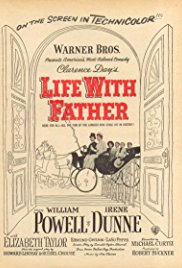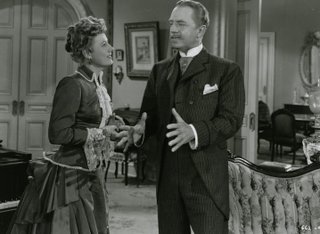LIFE WITH FATHER
SUBJECTS — U.S./1865-1913 & New York;
SOCIAL-EMOTIONAL LEARNING — Coming of Age, Father/Son; Marriage;
MORAL-ETHICAL EMPHASIS — Caring.
AGE: 8+; No MPAA Rating;
Comedy; 1947; 118 minutes; Color. Available from Amazon.com.
There is NO AI content on this website. All content on TeachWithMovies.org has been written by human beings.

SUBJECTS — U.S./1865-1913 & New York;
SOCIAL-EMOTIONAL LEARNING — Coming of Age, Father/Son; Marriage;
MORAL-ETHICAL EMPHASIS — Caring.
AGE: 8+; No MPAA Rating;
Comedy; 1947; 118 minutes; Color. Available from Amazon.com.
TWM offers the following worksheets to keep students’ minds on the movie and direct them to the lessons that can be learned from the film.
Film Study Worksheet for ELA Classes and
Worksheet for Cinematic and Theatrical Elements and Their Effects.
Teachers can modify the worksheets to fit the needs of each class. See also TWM’s Movies as Literature Homework Project.
In this movie, we are treated to a few weeks in the life of the Days, a zany family living in New York in the 1890s. The father is bombastic but loving. The five redheaded sons get into all kinds of mischief. The mother is usually able to smooth things over, but not always.
There are several subplots: the boys are recruited by a patent medicine maker to peddle his brew to the neighbors, they test it on their mother and almost kill her; the boys blow up part of the house with an “invention;” they get into scrapes with a girl and so on. The mother and father have hilarious contretemps about visits by her relatives and the mother’s anxiety over the father’s refusal to be baptized.
“Life With Father” spoofs everything it can reach including religious orthodoxy, superstition, and authoritarian fathers. The film is based on the successful Broadway play by Linsday Howard and Russell Crouse which in turn was based on a novel of the same name.
Selected Awards:
1948 Golden Globe Awards: Best Score; 1947 New York Film Critics Awards: Best Actor (Powell); 1947 Academy Award Nominations: Best Actor (Powell), Best Art Direction/Set Decoration (Color), Best Color Cinematography, Best Score.
Featured Actors:
William Powell, Irene Dunne, Elizabeth Taylor, Edmund Gwenn, ZaSu Pitts, Jimmy Lydon, Martin Milner.
Director:
Michael Curtiz.
The movie shows the life of a daffy well-to-do family in New York in the 1890s. Many perennial subjects of American life are touched upon, including invention, patent medicine and the friction between free thinking and religious orthodoxy.
MINIMAL. There are some fleeting references to Africa in stereotyped terms. The criticism of religious orthodoxy is good or bad depending upon your beliefs.
Ask and help your child to answer the Quick Discussion Question.

A superstition is a belief or an attitude based on fear or ignorance and which is inconsistent with the known laws of science. In the movie, Mr. Day and the sons have red hair. A housemaid on her first day on the job, believing that redheads are bad luck, casts a spell to protect herself each time she sees another redheaded child come down the stairs for breakfast.
Patent medicines and their cousins, miracle cures, have been a perennial feature of life in the U.S. and many other countries. Patent medicine vendors traversed the United States from the frontier to the cities. Often the “medicines” were worse for the patient than the disease, which they almost never cured. This was the case with Mrs. Day. Often these “medicines” contained a large percentage of alcohol or some other drug that made people think they were better but which did not cure any illness.
In the 1890s, most men of Clarence Day’s conservative persuasion believed that women did not have the mental capacity to understand politics. Many women disagreed and there was a growing woman’s suffrage movement. Women attended many lectures and programs to educate themselves and prove their ability to handle political arguments. Women were granted the vote throughout the U.S. in 1920 on the passage of the 19th Amendment to the U.S. Constitution. See Learning Guide to Anne of Green Gables.
1. See Discussion Questions for Use With any Film that is a Work of Fiction.
2. Do you agree that the father could be a good Christian without being baptized?
3. What did the boys do wrong in testing the elixir on their mother?
4. Was the mother right to try to get the father to be baptized when he didn’t want to be?
5. Was the father right to think that he could belong to a church that required baptism but still not be baptized?
6. Do you agree with the father that God wouldn’t keep him out of heaven on a technicality (i.e., not being baptized)?
7. Name the superstitions shown in the film. Do you know any others?
1. How did this marriage work? Was it successful?
2. Evaluate the mother and father characters in this film as parents.
3. How does the oldest boy get into trouble when he tries to act like his father?
(Additional questions are set out in the “Parenting – Father/Son” section above.)
Discussion Questions Relating to Ethical Issues will facilitate the use of this film to teach ethical principles and critical viewing. Additional questions are set out below.
1. Analyze the actions of any major character in the film applying two tests which any ethical action must pass: (1) The Golden Rule (Would the person taking the action want to be treated the same way? Or to put it another way “Do unto others as you would have others do unto you”) and (2) universality (Would there be a positive effect on society if everyone acted the same way in a similar situation?).
2. The plots of most films turn on one or more ethical choices which must be made by the characters in the movie. Which of The Six Pillars of Character, if any, are involved in the plot of this film? Tell us whether the ethical decisions made by the characters complied with the standards set out in the Six Pillars. Justify your opinion.
For convenience, the Six Pillars of Character are set out below.
(Be honest; Don’t deceive, cheat or steal; Be reliable — do what you say you’ll do; Have the courage to do the right thing; Build a good reputation; Be loyal — stand by your family, friends, and country)
(Treat others with respect; follow the Golden Rule; Be tolerant of differences; Use good manners, not bad language; Be considerate of the feelings of others; Don’t threaten, hit or hurt anyone; Deal peacefully with anger, insults, and disagreements)
(Do what you are supposed to do; Persevere: keep on trying!; Always do your best; Use self-control; Be self-disciplined; Think before you act — consider the consequences; Be accountable for your choices)
(Play by the rules; Take turns and share; Be open-minded; listen to others; Don’t take advantage of others; Don’t blame others carelessly)
(Be kind; Be compassionate and show you care; Express gratitude; Forgive others; Help people in need)
(Do your share to make your school and community better; Cooperate; Stay informed; vote; Be a good neighbor; Obey laws and rules; Respect authority; Protect the environment)
A book about this period suitable for middle school and junior high readers is Turn of the Century by Nancy Smiler-Levinson. Cross Your Fingers, Spit in Your Hat: Superstitions and Other Beliefs, by Alvin Schwartz, a collection of American superstitions, has also been recommended for this age group.
This Learning Guide was last updated on December 10, 2009.